Peppers can be defined in several ways. But, we can all agree that when someone mentions the word peppers, it usually refers to as the bell peppers. People use them in cooking for the preparation of numerous tasty meals, which makes it an extremely versatile food.
Can guinea pigs eat peppers? Guinea pigs can eat peppers but not all types are good for them. They can eat sweet peppers such as bell peppers. However, spicy/hot peppers like jalapenos have just too much heat in them and can cause serious problems in a guinea pig’s stomach.
We have covered everything for peppers and guinea pigs in the sections below, such as what peppers can guinea pigs eat, can guinea pigs have peppers every day, including some more general information about bell peppers. Let’s begin!
Table of Content
Are Peppers Good for Guinea Pigs? | Health Benefits
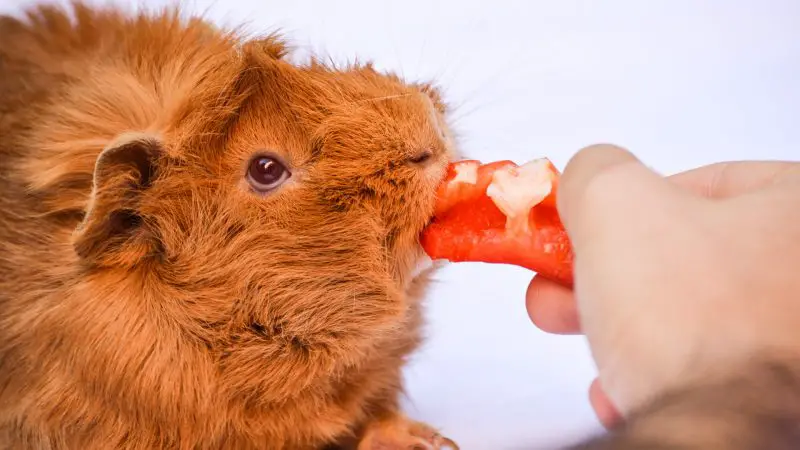
Peppers are very tasty for guinea pigs and they come with many health benefits for them as well. The nutrients in peppers improve their overall health but they also have some nutrients like sugar, which are not so beneficial for the guinea pigs. Now, let’s see all the benefits regarding bell peppers as food for guinea pigs:
Good Digestion
Bell peppers have a normal amount of fibers and this can be good for their digestion if they are served in moderation to guinea pigs. Too much fiber can cause loose stool while a proper serving size will improve bowel movements. This means that a normal amount of fibers will contribute to good digestion. Lack of fibers will result in constipation, and excess of fibers causes diarrhea.
Healthy Blood and Blood Vessels
The pantothenic acid in the peppers helps with creating red blood cells, and the iron helps the organism fight off anemia. The deficit of iron shows through fatigue, anemia, bad immunity, and loss of appetite. The B6 vitamin can prevent anemia, but also it reduces stress, helps in producing more serotonin (happiness hormone), and also it can help improve the guinea pig’s sleep.
Antioxidants
Peppers are low in calories and exceptionally rich in vitamin C and other antioxidants, making them an excellent addition to any healthy diet. Vitamin A in peppers will “hunt down” the free radicals in the guinea pig’s body and prevent further damage. Also, there will be less risk of different diseases and the immunity will be kept in good shape.
Vitamin C and Scurvy Prevention
In peppers, there is also vitamin C, and we know that this vitamin is a must-have for a healthy guinea pig. Without it, the poor little cavies can get scurvy, which is a deadly disease for them. Luckily, bell peppers are very rich in vitamin C.
Eyes Health
We already know that carrots are good for the eyes of your little pet. But there are also carotenoids lutein and zeaxanthin in peppers which are good for guinea pig’s eyes. These carotenoids are especially high in green and orange bell peppers. It is also known that they can improve eye health in guinea pigs when consumed in reasonable amounts.
Other Benefits
A lot of health benefits are coming from other vitamins, such as vitamin E that keep the skin healthy, reduce inflammation, keep the eyesight in good health, and even reduce the risk of some cancers. Riboflavin is also known as the B2 vitamin helps with better transfer of oxygen in the body and it helps to break down the food into energy. Also, niacin or B3 vitamins can lower cholesterol levels.
Minerals, such as magnesium, in peppers help regulate pains in the muscles, but it also prevents diabetes, migraines, and heart diseases. Zinc helps with reducing skin irritations.
Nutrition Facts of Peppers for Guinea Pigs
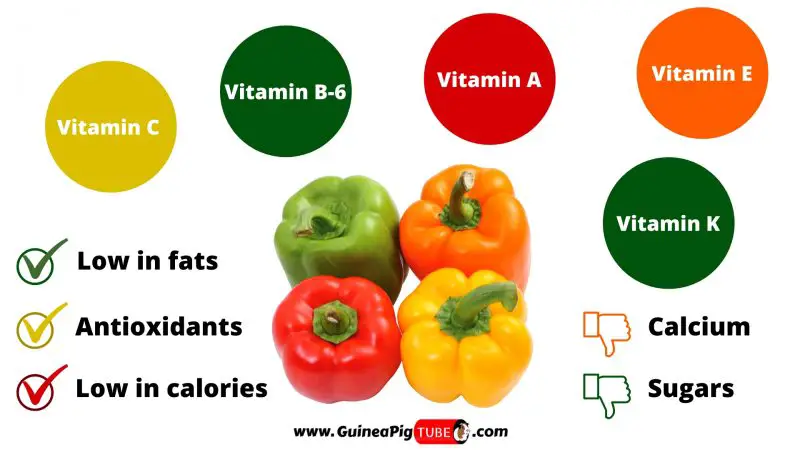
These are nutritional information for 100 g of green, yellow and red peppers.
| Nutrients | Green Peppers | Yellow Peppers | Red Peppers |
| Energy | 20 kcal | 27 kcal | 31 kcal |
| Protein | 0.86 g | 1 g | 0.99 g |
| Total lipid (fat) | 0.17 g | 0.21 g | 0.3 g |
| Carbs | 4.64 g | 6.32 g | 6.03 g |
| Dietary Fiber | 1.7 g | 0.9 g | 2.1 g |
| Sugars | 2.4 g | – | 4.2 g |
| Calcium | 10 mg | 11 mg | 7 mg |
| Iron | 0.34 mg | 0.46 mg | 0.43 mg |
| Magnesium | 10 mg | 12 mg | 12 mg |
| Potassium | 175 mg | 212 mg | 211 mg |
| Zinc | 0.13 mg | 0.17 mg | 0.25 mg |
| Vitamin C | 80.4 mg | 183.5 mg | 127.7 mg |
| Vitamin B-6 | 0.224 mg | 0.168 mg | 0.291 mg |
| Vitamin A | 18 µg | 10 µg | 157 µg |
| Vitamin E | 0.37 mg | – | 1.58 mg |
| Vitamin K | 7.4 µg | – | 4.9 µg |
| Riboflavin | 0.028 mg | 0.025 mg | 0.085 mg |
| Niacin | 0.48 mg | 0.89 mg | 0.979 mg |
| Folate | 10 µg | 26 µg | 46 µg |
| Lutein + zeaxanthin | 341 µg | – | 51 µg |
Is Pepper Bad for Guinea Pigs? | Possible Risks
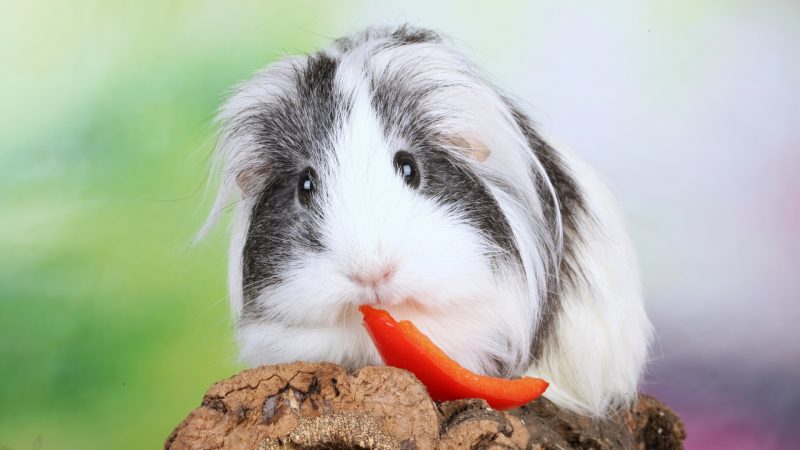
It’s important to know if you can give peppers to guinea pigs without any risks. Not all peppers are good for guinea pigs, especially in large serving sizes. We are going to explore some possible risks in the following sections below:
Painful Digestion and Stool Changes
If you feed the guinea pig too many peppers or too often, some problems with digestion can arise. Excess of fibers and also sugars will cause painful digestion, flatulence, gases, and most likely loose stool along with stomach cramps.
Urinary Problems
When your guinea pig is fully grown, it doesn’t need that much calcium compared to when it was young. In fact, excess calcium can cause bladder and kidney stones. But, also there is a risk of getting bloody urine and painful urinary infections as well.
Allergies
Sometimes guinea pigs can develop allergies to certain foods, so you need to be careful when feeding peppers to them for the first time. Rarely, they can be allergic to bell peppers. But if you notice that your guinea pig has diarrhea or it starts vomiting even if you give it only a small amount of peppers, immediately stop the feeding process and visit the vet.
Serving Size and Frequency of Peppers for Guinea Pigs
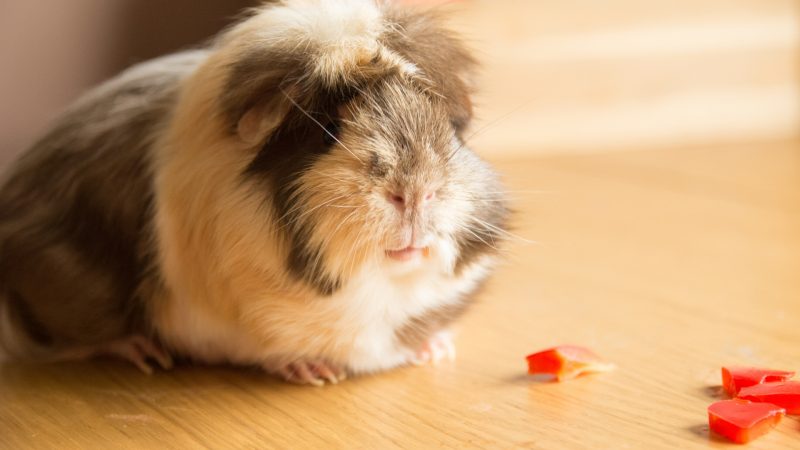
Can Guinea Pigs Eat Peppers Daily?
Guinea pigs shouldn’t eat peppers daily. Some owners give their guinea pigs a slice of pepper every day. But in order to avoid any health problems (like bad digestion), try a slice or two every other day or 2 to 3 times per week.
There are many other fruits and vegetables and it is important to provide guinea pigs with a varied and rich diet, but if you don’t have any other vegetables on hand you can give them peppers more than 3 times a week.
Can Guinea Pigs Eat Whole Peppers?
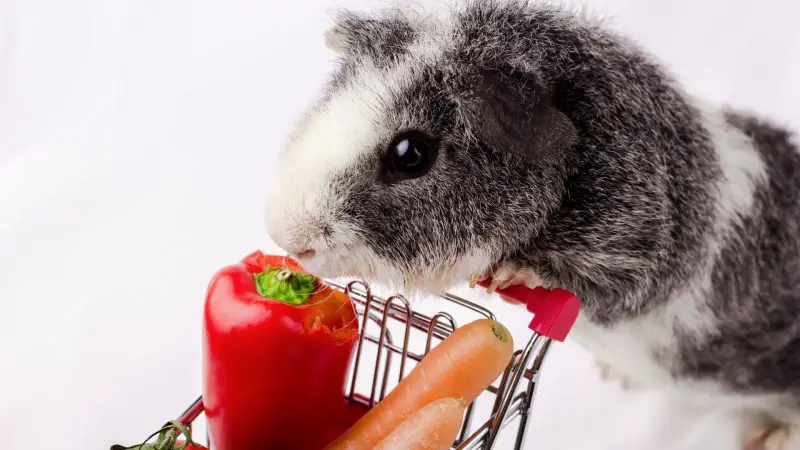
Guinea pigs shouldn’t eat the whole pepper because they are small animals and an entire pepper can cause them digestion problems. Serving size is simple – half a cup or one to two slices of pepper for one guinea pig. You can even go for a full cup but guinea pigs need to have a rich diet full of different veggies in combination with hay and pellets.
Moreover, preparation is simple. Cut the peppers in small slices and feed them to your guinea pig. You need to thoroughly wash every vegetable you are going to feed your pet.
Do Guinea Pigs Like Peppers?
Guinea pigs like to eat peppers because they are very tasty and crispy. Usually, guinea pigs enjoy eating red peppers. They are the sweetest ones, but be careful with serving sizes.
There aren’t many reports from owners that their guinea pigs don’t like to eat peppers. But if your guinea pigs, for some reason, don’t like peppers or have some allergies, just give them other vegetables such as spinach, celery, broccoli, kale, and so on.
What Kind of Peppers Can Guinea Pigs Eat?
There are many types of peppers. They are different in shape, taste, and color. But, what are the best types of pepper for guinea pigs and what types do they like to eat the most? Let’s find out!
Can Guinea Pigs Eat Bell Peppers/Sweet Peppers?
The bell peppers are also known as sweet peppers and they are one of the most popular and healthy vegetables in the world. Guinea pigs can eat bell or sweet peppers and they are completely good and safe for them.
These peppers are the only peppers guinea pigs can eat because they are sweet, rich in vitamin C, and antioxidants. You need to avoid feeding guinea pigs with hot peppers. Just like with any other vegetable, feed bell peppers to guinea pigs only in moderation.
Can Guinea Pigs Eat Mini Sweet Peppers?
Guinea pigs can eat mini sweet peppers and they are good for them. These peppers are a smaller version of bell peppers. They look similar but mini sweet peppers are usually sweeter in taste. So, it’s recommended to feed guinea pigs with mini sweet peppers only in moderation and a few times per week.
Can Guinea Pigs Eat Green Peppers?
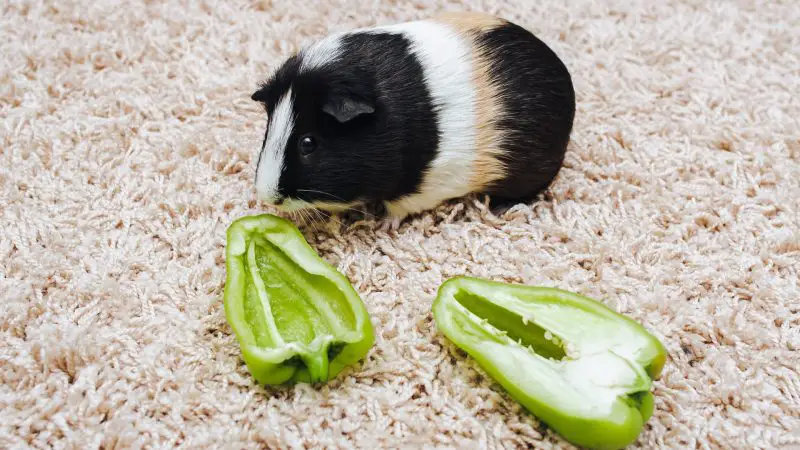
Green peppers are the unripe versions of red peppers and they are rich in numerous nutrients. Guinea pigs can eat green peppers and these peppers have many health benefits for them. First of all, green peppers are naturally low in fat, sugar, and calories, but at the same time rich in vitamin C, vitamin A, and many other antioxidants.
Also, green peppers are especially high in lutein and zeaxanthin which are good for guinea pig’s eyes. Despite many health benefits, you need to feed green peppers to guinea pigs only in moderation due to the high calcium content in them. Guinea pigs need food that is low in calcium because too much calcium can cause kidney stones.
Can Guinea Pigs Eat Red Peppers?
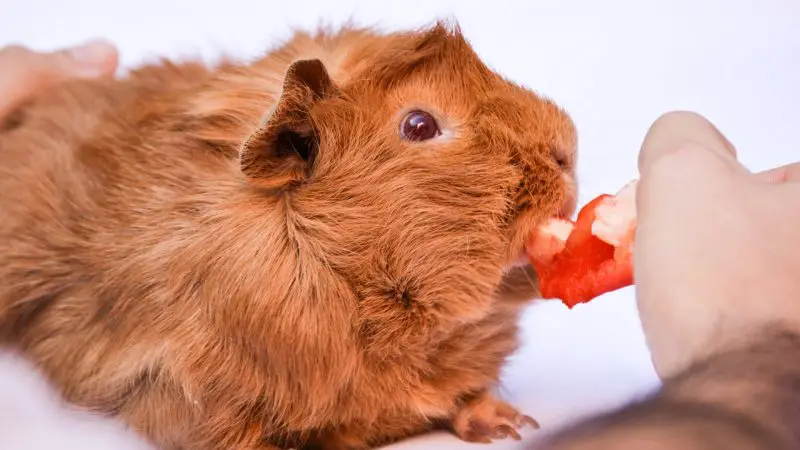
Red peppers are sweeter than green and yellow bell pepper varieties. Guinea pigs can eat red bell peppers and they enjoy eating them. These peppers are especially high in vitamin C, vitamin A and other antioxidants that are good for guinea pigs’ health.
Although red bell peppers have more vitamin C and vitamin A and have a smaller amount of calcium than green peppers, you need to feed them to guinea pigs only in moderation. It has a high sugar content which can cause diarrhea or even diabetes.
Can Guinea Pigs Eat Jalapeno Peppers?
Jalapeno peppers are dark green chili peppers with medium to high heat and guinea pigs can’t eat them because they have a very sensitive digestive system and these peppers can be very harmful to the guinea pig’s stomach.
Guinea pigs shouldn’t eat any other hot peppers because feeding guinea pigs with hot peppers can be bad for them, just like the case with jalapeno peppers. Despite vitamins and minerals in hot or spicy peppers, you shouldn’t feed them to guinea pigs. Also, you need to avoid any other spicy food in their diet.
Can Guinea Pigs Eat Banana Peppers?
Guinea pigs shouldn’t eat banana peppers because these peppers are part of the chili pepper family that we’ve mentioned above. Banana peppers are less hot than jalapenos pepper. But still, they can be very harmful to guinea pigs and their digestive system.
It is important to note that there are also sweet banana peppers that guinea pigs can eat. Sweet banana peppers have almost the same taste as the bell peppers but they have a different look and their shape resembles that of a banana.
Can Guinea Pigs Eat Orange Peppers?
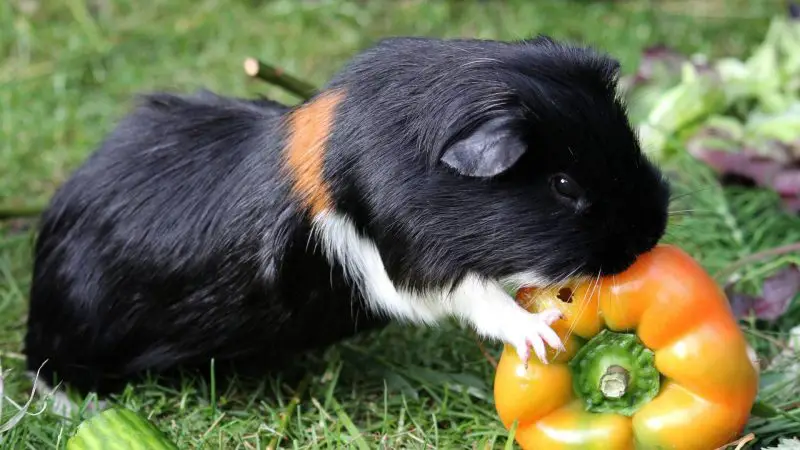
Orange peppers are sweet bell peppers and they contain many good nutrients. Guinea pigs can eat orange peppers. They are good for them because these peppers are a great source of vitamin C and other antioxidants. But also it’s recommended to feed orange bell peppers to guinea pigs only in small amounts and two to three times per week because of the sugar content in them.
Can Guinea Pigs Eat Yellow Peppers?
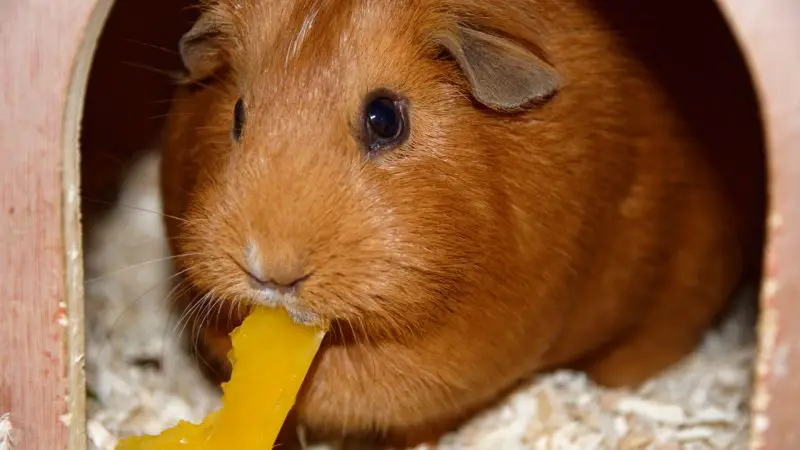
Yellow bell peppers are very popular among people. Guinea pigs can eat yellow peppers and these peppers are good and safe for them if feed in moderation.
Yellow bell peppers have many beneficial minerals for guinea pigs such as iron, magnesium, and potassium that are good for the heart if consume in normal amounts. But there are also some amounts of calcium and sugars, so you need to feed them to guinea pigs only a few times per week, like the other bell peppers.
Can Guinea Pigs Eat Purple Peppers?
Guinea pigs can eat purple peppers and these peppers are safe for them. Purple bell peppers have many nutrients, such as vitamin C, vitamin A, and other antioxidants that are good for guinea pigs’ overall health. Also, feed purple bell peppers to guinea pigs only in small amounts and not too often because of the sugar and calcium content.
More Information About Peppers and Guinea Pigs
Can Guinea Pigs Eat Peppers Seeds?
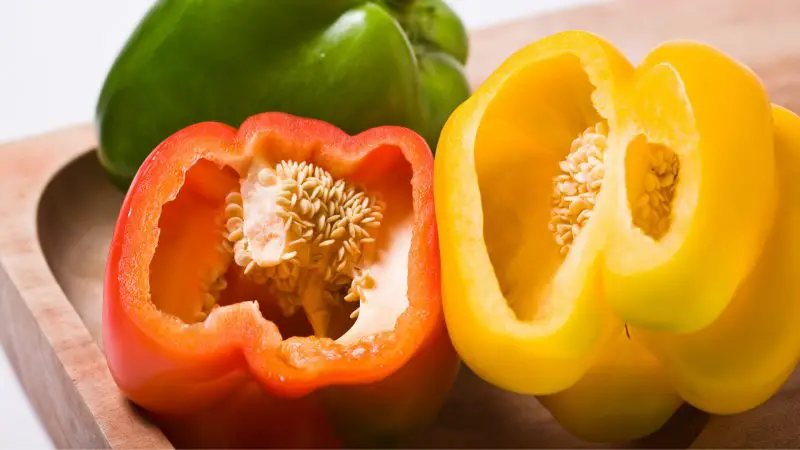
Many people remove peppers seeds and white parts inside the peppers before eating. Guinea pigs can eat pepper seeds because these seeds aren’t poisonous and they don’t have any toxic effect on your pet. Many owners have reported that they feed peppers seeds to guinea pigs. But despite that, we recommend removing peppers seeds before giving them to guinea pigs.
Although peppers seeds are small and soft, there is a risk of them being a choking hazard. Guinea pigs enjoy the flash of the peppers, which is delicious for them while pepper seeds can be bitter in taste. If you remove the pepper seeds, you will be sure that your guinea pigs will not choke on them.
Can Guinea Pigs Eat Pepper Leaves?
Guinea pigs can’t eat pepper leaves because these leaves can contain some alkaloids that can be toxic to guinea pigs. Despite people eating cooked pepper leaves, guinea pigs can’t eat them because their digestive system isn’t made to digest any cooked food. There are many other types of leaves that guinea pigs can eat and there is no point in taking risks with pepper leaves.
Can Guinea Pigs Eat Pepper Stalks/Stems?
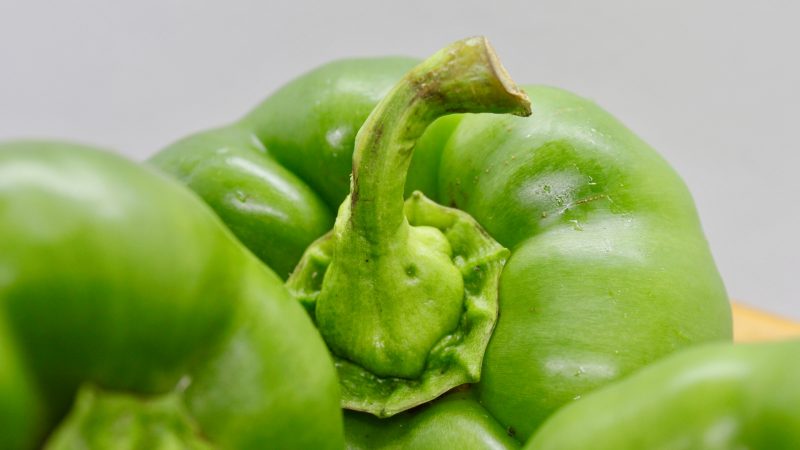
Guinea pigs can’t eat pepper stalks or pepper stems because they also can contain some alkaloids, just like leaves that can be poisonous to guinea pigs. When you feed peppers to your guinea pigs, it’s best to remove pepper tops, stems, and seeds. It is also recommended to wash the pepper thoroughly with water, slice it into smaller parts or just cut it in half and give it to your guinea pigs.
Quick Facts on Peppers
The following are some of the quick facts about peppers:
- The red bell peppers are in fact green peppers that were left to ripen fully.
- There is more vitamin C in red peppers than in green ones.
- Peppers originate from South and Central America.
- The seeds for bell peppers were brought to Spain back in 1493. From there, they were introduced to other European countries, as well as Asia.
- The most common colors of the peppers are red, orange, yellow, and green, but there are also other types like purple, white and brown.
- China produces the most bell peppers worldwide, after that comes Turkey, Mexico, USA, and Indonesia.
- The packs of 1 green, 1 yellow, and 1 red pepper are called “Traffic Light Peppers” in many supermarkets.
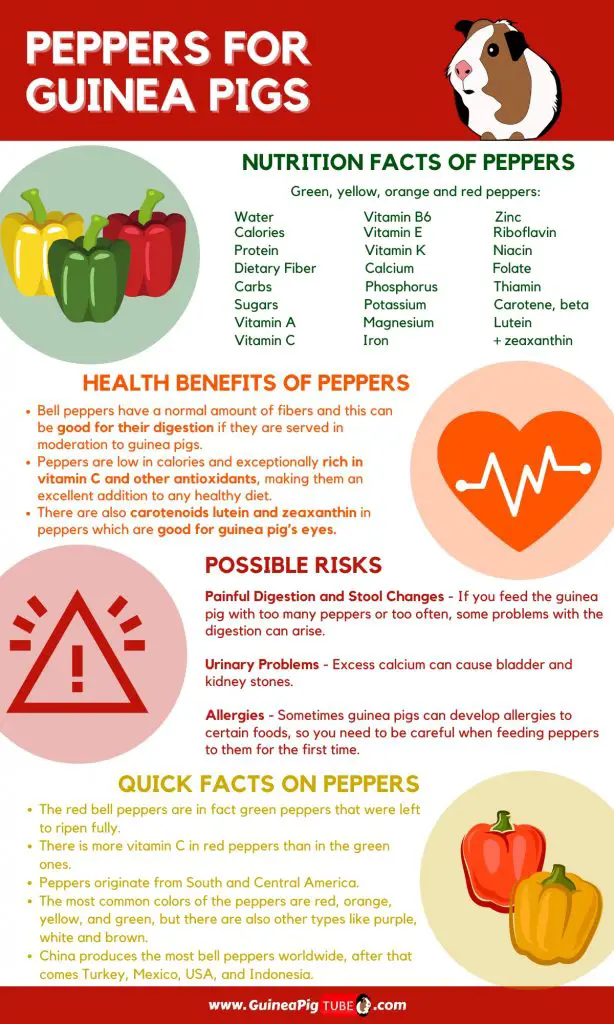
With food, you should be careful what to choose. If you are not sure what to feed them but believe your little piggies deserve some great treats, check our Helpful Guide to the Best Guinea Pig Treats to get some ideas.
We have also made a full list of foods that guinea pigs can and can’t eat (150+ Types of Foods). Be sure to also check our recommended products page for everything you will ever need to assure a happy life for your Guinea Pigs. Hope this information was helpful and you have found the answer you were looking for.
List of Sources
Nutrient Requirements of Laboratory Animals
Vitamin C Requirements of the Guinea-Pig
Dietary Requirements of the Guinea Pig With Reference to the Need for a Special Factor
